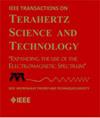Flat Silicon Gradient Index Lens With Deep Reactive-Ion-Etched Three-Layer Antireflection Structure for Millimeter and Submillimeter Wavelengths
IF 3.9
2区 工程技术
Q2 ENGINEERING, ELECTRICAL & ELECTRONIC
IEEE Transactions on Terahertz Science and Technology
Pub Date : 2025-03-27
DOI:10.1109/TTHZ.2025.3555418
引用次数: 0
Abstract
In this article, we present the design, fabrication, and characterization of a 100 mm diameter, flat, gradient-index (GRIN) lens fabricated with high-resistivity silicon, combined with a three-layer antireflection (AR) structure optimized for 160–355 GHz. Multidepth, deep reactive-ion etching enables patterning of silicon wafers with subwavelength structures (posts or holes) to locally change the effective refractive index and, thus, create AR layers and a radial index gradient. The structures are nonresonant and, for sufficiently long wavelengths, achromatic. Hexagonal holes varying in size with distance from the optical axis create a parabolic index profile decreasing from 3.15 at the center of the lens to 1.87 at the edge. The AR structure consists of square holes and cross-shaped posts. We have fabricated a lens consisting of a stack of five 525 μm thick GRIN wafers and one AR wafer on each face. We have characterized the lens over the frequency range 220–330 GHz, obtaining behavior consistent with Gaussian optics down to −14 dB and transmittance of 99具有深反应-离子蚀刻三层增透结构的毫米和亚毫米波长平面硅梯度折射率透镜
在这篇文章中,我们介绍了设计、制造和表征一个直径100毫米的平面梯度折射率(GRIN)透镜,该透镜由高电阻硅制成,并结合了优化为160-355 GHz的三层增透(AR)结构。多深度、深反应离子蚀刻使具有亚波长结构(柱或孔)的硅片图像化能够局部改变有效折射率,从而创建AR层和径向折射率梯度。这些结构是非共振的,对于足够长的波长,是消色差的。六角形孔的大小随距光轴的距离而变化,形成抛物线折射率剖面,从透镜中心的3.15下降到边缘的1.87。AR结构由方孔和十字形柱组成。我们制作了一个由5个525 μm厚的GRIN晶圆堆叠而成的透镜,每个表面上有一个AR晶圆。我们在220-330 GHz的频率范围内对透镜进行了表征,获得了与高斯光学一致的性能,低至- 14 dB,透过率为99$\pm$3%。
本文章由计算机程序翻译,如有差异,请以英文原文为准。
求助全文
约1分钟内获得全文
求助全文
来源期刊

IEEE Transactions on Terahertz Science and Technology
ENGINEERING, ELECTRICAL & ELECTRONIC-OPTICS
CiteScore
7.10
自引率
9.40%
发文量
102
期刊介绍:
IEEE Transactions on Terahertz Science and Technology focuses on original research on Terahertz theory, techniques, and applications as they relate to components, devices, circuits, and systems involving the generation, transmission, and detection of Terahertz waves.
 求助内容:
求助内容: 应助结果提醒方式:
应助结果提醒方式:


